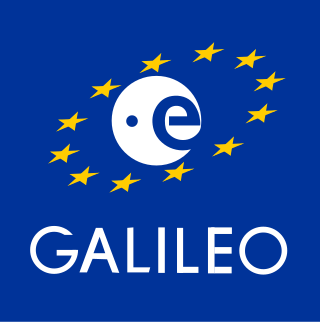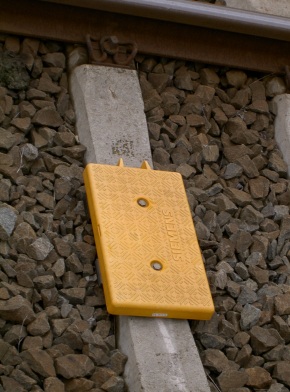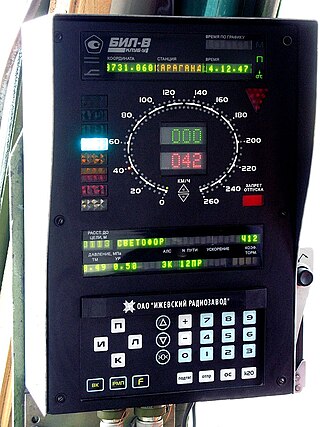
Galileo is a global navigation satellite system (GNSS) created by the European Union through the European Space Agency (ESA) and operated by the European Union Agency for the Space Programme (EUSPA). It is headquartered in Prague, Czechia, with two ground operations centres in Oberpfaffenhofen, Germany, and in Fucino, Italy,. The €10 billion project went live in 2016. It is named after the Italian astronomer Galileo Galilei.

The European Geostationary Navigation Overlay Service (EGNOS) is a satellite-based augmentation system (SBAS) developed by the European Space Agency and EUROCONTROL on behalf of the European Commission. Currently, it supplements GPS by reporting on the reliability and accuracy of their positioning data and sending out corrections. The system will supplement Galileo in the future version 3.0.

A balise is an electronic beacon or transponder placed between the rails of a railway as part of an automatic train protection (ATP) system. The French word balise is used to distinguish these beacons from other kinds of beacons.

A satellite navigation or satnav system is a system that uses satellites to provide autonomous geopositioning. A satellite navigation system with global coverage is termed global navigation satellite system (GNSS). As of 2024, four global systems are operational: the United States's Global Positioning System (GPS), Russia's Global Navigation Satellite System (GLONASS), China's BeiDou Navigation Satellite System (BDS), and the European Union's Galileo.

The European Train Control System (ETCS) is a train protection system designed to replace the many incompatible systems used by European railways, and railways outside of Europe. ETCS is the signalling and control component of the European Rail Traffic Management System (ERTMS).

Real-time kinematic positioning (RTK) is the application of surveying to correct for common errors in current satellite navigation (GNSS) systems. It uses measurements of the phase of the signal's carrier wave in addition to the information content of the signal and relies on a single reference station or interpolated virtual station to provide real-time corrections, providing up to centimetre-level accuracy. With reference to GPS in particular, the system is commonly referred to as carrier-phase enhancement, or CPGPS. It has applications in land surveying, hydrographic surveying, and in unmanned aerial vehicle navigation.
GIOVE, or Galileo In-Orbit Validation Element, is the name for two satellites built for the European Space Agency (ESA) to test technology in orbit for the Galileo positioning system.
The GPS-aided GEO augmented navigation (GAGAN) is an implementation of a regional satellite-based augmentation system (SBAS) by the Government of India. It is a system to improve the accuracy of a GNSS receiver by providing reference signals. The Airports Authority of India (AAI)'s efforts towards implementation of operational SBAS can be viewed as the first step towards introduction of modern communication, navigation and surveillance / air traffic management system over the Indian airspace.
The European Rail Traffic Management System (ERTMS) is the system of standards for management and interoperation of signalling for railways by the European Union (EU). It is conducted by the European Union Agency for Railways (ERA) and is the organisational umbrella for the separately managed parts of
The European Union Space Programme is an EU funding programme established in 2021 along with its managing agency, the European Union Agency for the Space Programme, in order to implement the pre-existing European Space Policy established on 22 May 2007 when a joint and concomitant meeting at the ministerial level of the Council of the European Union and the Council of the European Space Agency, known collectively as the European Space Council, adopted a Resolution on the European Space Policy. The policy had been jointly drafted by the European Commission and the Director General of the European Space Agency. This was the first common political framework for space activities established by the European Union (EU).

A Eurobalise is a specific type of a balise installed between the rails of a railway. Eurobalises are part of the European train control system (ETCS). The balises are pre-programmed and contain information that is read by train antennas. One of their many functions is to allow a train to determine its location.
Transmission balise-locomotive is a train protection system used in Belgium and on Hong Kong's East Rail line.
In the field of geodesy, Receiver Independent Exchange Format (RINEX) is a data interchange format for raw satellite navigation system data. This allows the user to post-process the received data to produce a more accurate result — usually with other data unknown to the original receiver, such as better models of the atmospheric conditions at time of measurement.
ERTMS Regional is a simplified and low-cost variant of the European Rail Traffic Management System suitable for train control on lines with low traffic volumes. It is intended to reduce the amount of lineside and equipment required, thus reducing costs, increasing reliability and improving safety for track workers.

KLUB is the name of the modern Russian train control systems. The abbreviation "КЛУБ" stands for "Комплексное локомотивное устройство безопасности", Integrated Train Protection System.
A software GNSS receiver is a Global Navigation Satellite System (GNSS) receiver that has been designed and implemented using software-defined radio.
The European Satellite Navigation Competition (ESNC) is an annual international innovation competition that recognises downstream applications of satellite navigation. Anyone is free to enter. The ESNC was inaugurated in three regions in 2004 under the patronage of the Bavarian Ministry of Economic Affairs and is organised by Anwendungszentrum GmbH Oberpfaffenhofen (AZO). Since 2011, the competition is also supported by the European Commission. Until 2006, the ESNC was called “Galileo Masters" in reference to the European satellite navigation system Galileo.
Inside GNSS (IG) is an international controlled circulation trade magazine and website owned by Gibbons Media and Research LLC. It covers space-based positioning, navigation and timing (PNT) technology for engineers, designers, and policy-makers of global navigation satellite systems (GNSS). In the United States, GNSS is identified mainly with the government-operated Navstar Global Positioning System (GPS). InsideGNSS.com is the complimentary website of online news, events, digital newsletters, and webinars, and archived magazine articles.
The European Rail Traffic Management System (ERTMS) is an initiative backed by the European Union to enhance cross-border interoperability and the procurement of signalling equipment by creating a single Europe-wide standard for train control and command systems.

The European Union Agency for the Space Programme (EUSPA) is a space agency, managing the European Union Space Programme as one of the agencies of the European Union (EU). It was initially created as the European Global Navigation Satellite Systems Supervisory Authority (GSA) in 2004, reorganised into the European Global Navigation Satellite Systems Agency in 2010, and established in its current form on May 12, 2021. EUSPA is a separate entity from the European Space Agency (ESA), although the two entities work together closely.








